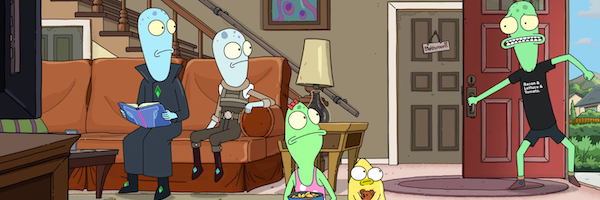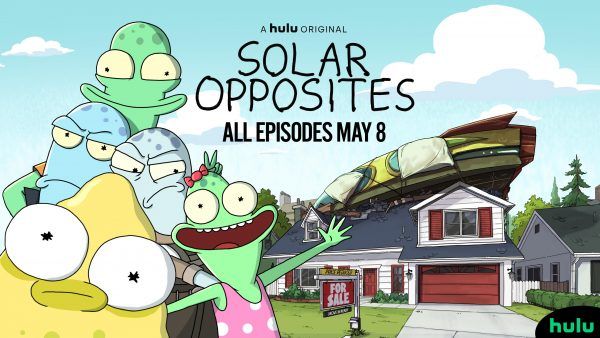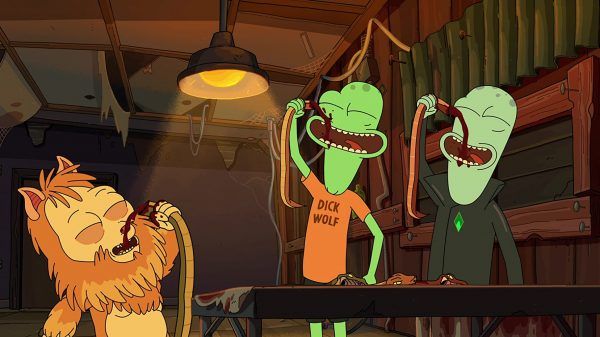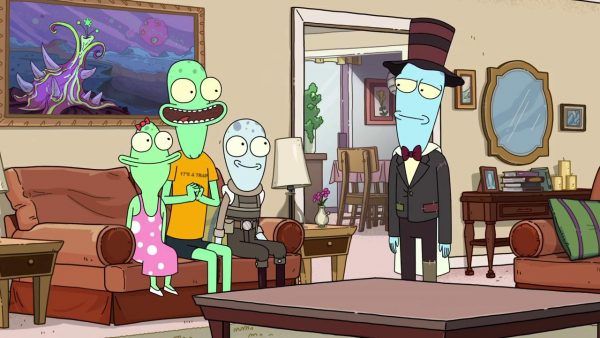The sitcom has been a staple of American TV since its inception. Whether it's I Love Lucy and The Honeymooners, or The Office and Brooklyn Nine-Nine, audiences have always been drawn to TV shows that poke fun at things we all experience in our daily life. Within the history of sitcoms, there's also a decades-long tradition of American cartoons taking the sitcom tropes and mixing them with the endless potential of the animation genre. Whether it's the many Fox animated shows like The Simpsons, or boundaries-pushing shows like Adult Swim's Rick and Morty, sitcoms and animation go together like Homer and beer. The latest torch-carrier for this tradition is Hulu's latest sitcom Solar Opposites.
Co-created by Mike McMahan and Justin Roiland, one half of the duo behind Rick and Morty, Solar Opposites is an animated sci-fi comedy that follows a team of four aliens who crash on Earth and must learn to deal with their new home and neighbors while also learning to be a family. The show mixes Roiland's crude humor and knack for violence — which is allowed to get way bolder with its NSFW content thanks to Hulu — with a long-standing tradition of animated sitcoms centered on a suburban family.
The Unfamiliar Family Unit
Though the cartoon sitcom existed since 1960 when The Flintstones became the first animated comedy to air on ABC in primetime, it didn't explode in popularity until Fox debuted a show about an animated family living in the fictional town of Springfield. As John Maher, the co-founder of animation-centric publication The Dot and Line tells Collider, "You can see the DNA of The Simpsons everywhere." Certainly, The Simpsons created the mold from which the past 30 years of adult animated sitcoms have come and gone. Whether it's Family Guy, King of the Hill, Daria, or even Roiland's own Rick and Morty, modern TV animation owes a lot to the family-centric storytelling that The Simpsons translated to the animation medium over 30 years ago.
It didn't matter how crazy Bart's antics got (like pranking the country of Australia) or how many times Mr. Burns tries to block the sun, the show always tied it back to the family at the center of the story and how much they cared for each other.
The family dynamic changed a bit with the years, with the dysfunctionality of the family being a key aspect of shows like King of the Hill, Daria, and Bob's Burgers putting their own spin on the traditional American family unit while still feeling broad enough to appeal to mass audiences. Similarly, Solar Opposites changes the formula and gives us a new take on the typical American family. The adults, Korvo (Roiland) and Terry (Thomas Middleditch) sometimes act like brothers while other times they act like a same-sex couple taking care of two kids — Yumyulack (Sean Giambrone) and Jesse (Mary Mack) — though they are not actually kids, but rather replicants.
Yumyulack and Jesse give us the brother/sister dynamic we've seen in countless other shows, but Solar Opposites tries to be provocative regarding gender roles. Yumyulack has typically masculine traits just as Jesse is often treated as a girl, but several moments in the show make it seem like Jesse is a bit more gender-fluid, especially given that she's a replicant of Terry, who is portrayed as masculine. Though not a huge part of the show, this could lead to some fascinating question in future seasons that further pushes the boundaries of what an animated sitcom can do.
The R-rated Humor
Though The Simpsons (especially Bart) was the subject of endless criticism from parents in the early years, it didn't do anything out of the ordinary for TV at the time. It wouldn't be until a comedy show based in a town in Colorado that animated sitcoms would become R-rated. "Once you get South Park, things start to change," said Maher. "That was when they sort of threw up everything against the wall and did whatever they wanted, and then a few years later, when Adult Swim hits, you get a stream of shows that really pave to the adult audience exclusively."
Though MTV was at its peak with shows such as Beavis and Butt-Head and Daria, the irreverent, vulgar, and provocative South Park paved the way for Adult Swim to become the adult-oriented animation giant we know today. Cable allowed animated sitcoms to take advantage of the medium's greater suspension of disbelief to explore more violence and vulgarity without being as offensive as a live-action show would be.
Solar Opposites pretty much feels like Rick and Morty unleashed. Under Hulu's uncensored umbrella, Roiland is able to explore all the sci-fi violence he hinted at with Rick and Morty but with a lot more graphic violence thrown in as well as uncensored profanity and sexual content. Each episode's formula involves Korvo and Terry accidentally unleashing some sci-fi creation that then gets out of control and gets a lot of people killed. Then, there's the show's side-story of the people trapped in the wall of Jesse's room, which our reviewer Dave Trumbore described as "something that's on par with 'Pickle Rick' and similar episodes of Rick and Morty." Like the Adult Swim show, Solar Opposites takes the familiar sitcom framework and also combines it with the goriest of action animation to hilarious results.
The Serialized Story
Once Adult Swim hits the airwaves, everything changed for the animated sitcom. Seasons got shorter, and suddenly a few shows started to play with the story structure by creating overarching stories that carried over from season to season. Maher points at the Adult Swim show The Venture Bros. as one of the most influential shows on television, because "The Venture Bros. did what almost no other show did until Archer, which was serializing the sitcom. By late Season 2, everything in The Venture Bros. was serialized." Indeed, since then we've had Archer devote entire seasons to a single, coherent story. Rick and Morty recently started exploring some serialized elements that added consequence to the characters' actions
Episodes of Solar Opposites follow a sitcom's standard formula of the family getting into some kind of trouble, then coming out the other side having learned something — only to forget about it the next episode. But the show's greatest strength involves the side-story of the miniaturized people that Yumyulack collects in the house. Throughout the season, we see the people in the wall living life and building a dystopian society with different social classes. Then the entirety of Episode 7 is devoted to a powerful and thrilling story that pays-off this entire side-story while setting up new narrative threads for next season. It may not end up like BoJack Horseman, with characters drastically changing with each season, but Solar Opposites is taking the lessons of Rick and Morty and pushing them forward by challenging the notion that nothing ever changes on a sitcom.
The American animated sitcom is a staple of American TV, and it is not going anywhere. As Maher told us, "Animated sitcoms are lasting because of the same reasons comedy shows are lasting," he said. "People want to laugh, and comedy is endlessly applicable to new concepts."
Solar Opposites may not be as groundbreaking as The Simpsons, but it is taking all the decades of history that came before it and pushing the boundaries little by little. Just like Korvo and Terry don't seem like they're leaving Earth anytime soon, Solar Opposites is here to stay.




